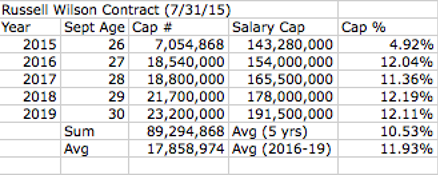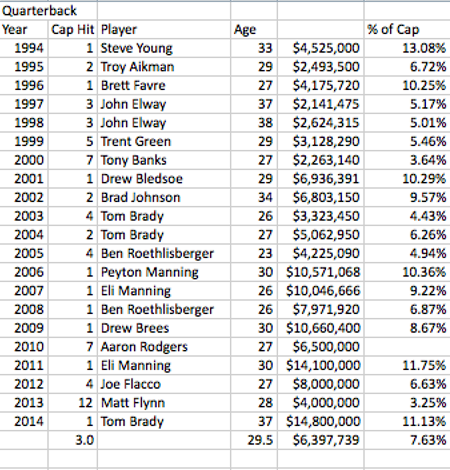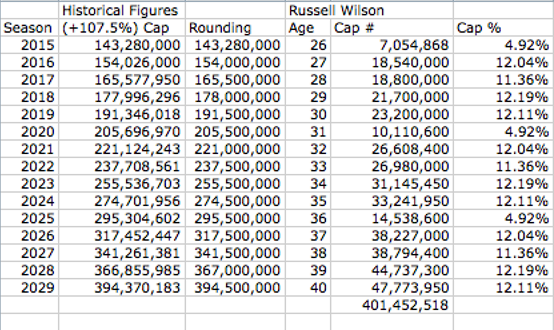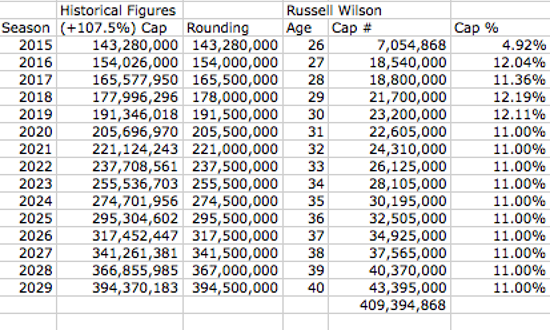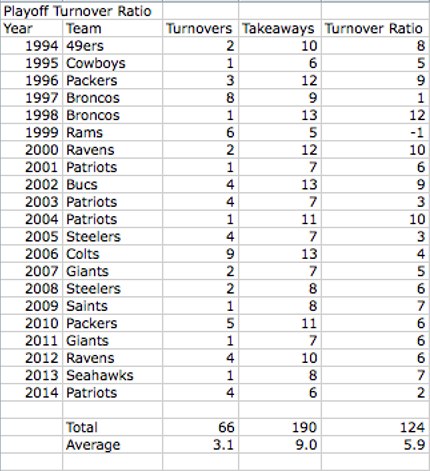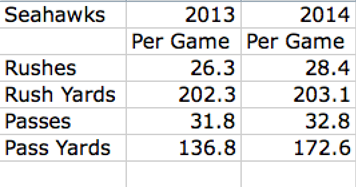Man, no matter what deal the Seahawks gave Russell Wilson there would have been detractors, huh? Some people saying that Wilson is now the most overpaid player in sports, others saying that he didn’t get a record or market setting deal, so there’s something wrong with that for the fourth year pro with two Super Bowl appearances in his career.
I’m here to hopefully dispel all of that and just talk about the contract itself, through my analysis of it. If you want to see what I predicted back in early June, here’s the link, it could actually give you a solid base to get you thinking of how both sides may have been approaching the deal as some of what I discussed ended up in this contract.
When I first saw four-years at $21.9 million per year, I flinched just because of how monstrous that is with Aaron Rodgers averaging $22 million per year and the last year of looking at his 13.20% cap hit in 2014, which really could have been the difference between a Super Bowl or the reality of what happened. With all the research I do regarding cap hits, my own biases had me thinking of $22 million at like 13% of the cap and with my knowledge that Steve Young’s 13.08% is not only a record setter, but high above Eli Manning’s second highest Super Bowl cap hit in 2011, 11.75%.
Luckily for the Seahawks, there was so much time between when Aaron Rodgers signed that extension before the 2013 season of a $123 million cap and today that $21.9 million is much more manageable.
As a reminder, the projected salary cap comes from this article I wrote on Justin Houston a few weeks ago, but was improved the next week with cap projections through 2021. (I included both because if you want to have all the information for how I arrived at those theories and you have that kind of interest in the salary cap, check out the ideas and see what you think yourself and if you see any flaws in my thought process.)
One thing I’m including in Caponomics is my dislike of contracts that use the first year as a low cap hit, then inflate the next few years in a way that takes them out of where the market should be in later years of the contract. While Wilson’s only at 4.92% in year one, the cap is moving at a rate, where his contract is not out of the market set by Super Bowl champions in later years.
With Houston’s contract, he will be far outside of the market that was set by those at his position, but with this Wilson contract, he is right within the area that he should be in. It’s very cool to see when teams stick within the same assumptions that you’ve created in regard to the cap percentage because, as a fan of Wilson’s, I want to see him succeed and I believe this contract gives him a great chance at succeeding as well as maximizing his earning potential.
Wilson’s biggest goal with this negotiation should have been to make a deal that pays him as much as he can earn during the course of it, while giving his team the best probability of being the best they can be these next few seasons. As a quarterback, your incentive to win is huge because quarterbacks are so hugely judged on their success in the playoffs, whether that’s how teams should look at quarterbacks or not, the bias definitely exists, so quarterbacks must keep it in mind.
As it was reported, Wilson is making $21.9 million per year, but the cap hit only ends up being $17,858,974, which then translates into five years with manageable cap hits if my projections are correct. In terms of the projections, I explained why I arrived at them in those two articles I linked, but simply put, I believe they are solid projections off the historical data and, while they will not be perfect, I don’t think they’ll be off by much. If anything, I believe that the salary cap could grow at even higher rates because of the opportunities in technology for the NFL, but those estimates are solid enough and backed with the past data.
A lot of people are arguing over if Wilson is worth that much based largely on how he performs statistically and the role that he plays. Well, the Seahawks know that there is a high probability that they can make the playoffs every year with a player like Wilson at quarterback if they don’t overpay him past a certain percentage of the cap. The incentive for both sides should be to figure out that balance of paying Wilson as much as possible with a lot cap percentage, so that both of them can grow their wealth long-term. In August 2014, Forbes calculated “that the Seahawks’ value soared 23 percent to $1.33 billion after their first Super Bowl season,” and their brand value continues to increase as they have this mini-dynasty that they’re trying to turn into long-term dominance. For Wilson, I’ve already explained his incentive to be on a winning team as he could really get a massive contract in 2020 with a salary cap that should be around $205.5 million and the 2021 cap could be at $221 million.
Just as an exercise, let’s imagine that Wilson and the Seahawks win one Super Bowl in the next five years and they’re competitive in the way that the Patriots are every year and they’re contending for an NFC championship. Considering that Wilson will be 26 in September of this year and 31 in September of the first year of his 2020 contract, he could have three more contracts structured in this exact manner with the same exact cap percentages as they’re about the pinnacle of where the quarterback should be and here is what the result for Russell Wilson’s projected earnings through his 40-year old season, which is when Brady is signed through, so this career projection is very possible if Wilson stays healthy and keeps improving and playing at this rate.
Think about that, if Wilson keeps playing like this and just uses those cap percentages, he could make $401.5 million over the next 15 years. Keep in mind that those 4.92% seasons don’t need to exist at that level, they could be a little higher in future years, which then could decrease some of the other figures or allow them to just pay him more money.
I personally believe that Tom Brady has set the top of where the quarterback market should be with his 11.13% of the cap in their 2014 Super Bowl season. Steve Young was on a team that used the uncapped 1993 season to re-sign 17 veterans in December of that year to avoid the 1994 salary cap, so his 13.08% cap hit should be taken with a grain of salt. We have reasons to be skeptical of Eli Manning’s 2011 cap hit as well as the 2011 Giants were, arguably, the worst team statistically to ever win a Super Bowl according to Kerry J. Byrne’s interesting take at Cold Hard Football Facts.
If you want to see the affect that cap percentages have had on the careers of Peyton Manning and Tom Brady, you might find this an interesting read.
So taking that 11.00% of the cap area, let’s look at what Wilson’s earnings would be if they just signed him for 11.00% of the cap from 2020 through the end of his career.
While he could potentially get in the neighborhood of 12-13% of the cap in these later years especially, I would highly recommend to both sides that they simply take the same approach that they took with this contract and make it have the same percentages of the contract be in a signing bonus and guaranteed.
I don’t want to get into the 11% of the cap contracts, so let’s just analyze what the current contract would look like if it were signed with the same percentages in 2020. This includes the same signing bonus and guarantees. To get that, we need to see the percentage of the cap hit that the signing bonus and base salary are because that’s what results in his cap hit and his contract figure.
Okay, so the Signing Bonus divided by Cap Number plus the Base Salary divided by Cap Number should result in 100% when you add them together. Then we take these estimates and we make them for a five-year contract in 2020 and here’s the result.
That means that it will be a contract worth about $128 million total over five-years, so $25.6 million per year with a $44.7 million signing bonus and about $80-85 million in guaranteed money. As we see from the other projection, this helps Wilson get to that end goal of around $400 million in career earnings through his 40-year old season.
It’s worth noting that Wilson also should want to stick with Carroll and stick with a system that’s working very, very well for him. In the current chapter I’m writing for Caponomics, I discuss the system that Carroll created at USC and has implemented in Seattle. Carroll’s goal with the system he created at USC was to come back to the NFL with an old school style of play and show teams that it still could be done this way.
The things Carroll learned in four combined seasons with the Jets and Patriots, during which he went 33-31, set him up for the perennial contender he has in Seattle. As John Clayton wrote in this piece right after the Seahawks beat down on the Broncos, “Pete Carroll went to USC to prove to himself that old-school football could work. To Carroll, that meant rugged defense and running the football, a mindset that he then imported to his next NFL stop with the Seattle Seahawks.” Interestingly, Carroll had to go back to college to perfect a system that was all about old-school football, a run-first, defensive mentality. In my research, it seems that once the league begins to make a philosophical shift, everything else from before can become forgotten. As Clayton writes, the team that the 2013 Seahawks most mirrors is the 1985 Bears, before the Seahawks, the Bears were “the last NFL defense to lead the league in fewest yards and fewest points allowed, as well as most takeaways.” In that Super Bowl game, they shut the Broncos out for three quarters and won the turnover battle by forcing four and giving up zero.
The 2013 Seahawks and 1985 Bears were built in a very similar way as perfected Run-First/Defensive modeled rosters. The Bears were first in rushing attempts (610), yards (2761) and touchdowns (27), while they were fifth in yards per carry (4.5). The Seahawks were second in attempts (509), fourth in yards (2188), but 12th in yards per carry, although only 0.2 yards per carry below that Bears team. Something that I’m toying with as a concept is whether or not Run-First/Defensive modeled teams need a mobile quarterback to succeed and, interestingly, both teams had one as Jim McMahon had 252 yards at 5.4 yards per carry with three rushing touchdowns and Russell Wilson is not only one of the best rushing quarterbacks in the NFL today, but could be one of the best ever. In 2013, Wilson had 539 rushing yards at 5.6 per carry, then in 2014, he had an astounding 829 yards at 7.2 per carry, which led the NFL. That aspect of Wilson’s game is a real x-factor that could be impactful for at least a decade as his ability to baseball slide from years playing the game at a high level, could keep him healthy enough to do so.
Both teams controlled the game through a great running game and then had a shutdown pass defense to make sure the opponent couldn’t engage them in a shootout. The Bears were third with 2816 passing yards allowed, only 176 per game, while the Seahawks were first, allowing only 2752 yards over 16 games, so 172 yards per game. The combination of a powerful running game and a great pass defense results in games where you dictate the pace and helps the defense keep the scoring down. Both teams were first in scoring and yardage defense and I think that’s in large part due to that combination of solid rushing offense and great pass defense. The Bears only gave up 12.4 points per game compared to 14.4 for the Seahawks.
Like the Bears of 1985, the Seahawks were near the bottom of the league in passing yards with the Bears 20th and Seahawks 26th. The most important factor was the Bears were sixth with only 16 interceptions thrown, while the Seahawks were third with only nine picks thrown. Doubly important, both teams were #1 in defensive interceptions as the Bears had 34 and the Seahawks had 28. That brings us into one of Carroll’s main philosophies and something that I’ve found a direct correlation to championship football teams: creating turnovers and protecting the football, turnover ratio.
Both the 1985 Bears and 2013 Seahawks were fourth in turnovers and first in takeaways. The Bears had 54 takeaways and 31 turnovers, resulting in a turnover ratio of +23, while the Seahawks had 39 takeaways and 19 turnovers, which means a +20 turnover ratio. Very solid numbers that mean they had at least one more turnover forced per game than their opponents, which is always a huge shift because of the addition and subtraction of a scoring opportunity for each team in the sense of a possession. I go over this concept in depth in this Moneyball vs. Caponomics piece.
Here are the playoff turnover ratios for the Super Bowl champions of the cap era:
Clayton writes that Carroll meets with Russell Wilson on Mondays and is constantly reminding him the value of protecting the football saying, “turnover ratio is the path to victory in the NFL.” This isn’t just a saying, as you can see, it’s clearly backed up with data as the margin for error in the NFL, and especially in the playoffs, is so small that a turnover for either side could make all the difference in the world.
Wilson’s larger cap figures will make it a little bit harder for the Seahawks to build a powerful running game and great defense in the future, but it won’t be an insurmountable task like it would be at 13-15% of the cap. Wilson could have probably gotten a contract that paid him 13-15% of the cap in some years on the open market, but I think that the deal he signed with Seattle fully maximizes his earnings, while allowing his team the best chance at success, which, again, gives him the best chance at long-term financial success.
Carroll proved at USC that his system has an ability to raise the level of performance at the quarterback position through surrounding his quarterbacks with elite talent, especially an elite running game. That 2005 team that lost to Texas at the Rose Bowl had Reggie Bush and Lendale White combing for 397 rushes for 3042 yards (7.7 ypc) and 40 touchdowns on the ground. This and their great defense helped Matt Leinart win a Heisman and look like a first round draft pick. I think that his experience at USC affects the way that Carroll looks at quarterback, which is why I think they took so much time negotiating down to as manageable a cap figure as possible, while allowing Wilson to earn what he’s worth financially.
Something that’s been a very interesting discovery this last month for me is how the spread offense is all about spreading the defense in every direction, which is why the great spreads today have a good run/pass balance in terms of yardage, not play calls. This is something that Carroll did at USC, but through an old school system, while Chip Kelly is attempting to do it through the spread. In 2005, USC had 260 rushing yards per game on 40 carries and 320 passing yards per game on 37 passes, that’s a very solid split and something that you’ll find in Kelly’s Oregon teams as well as schools like Baylor who run the spread well. If you want to see what Kelly’s trying to create, but also the perils of running a pass-heavy spread with no running game, check out the 2008 game between Oklahoma and Texas Tech box score. It’s just a perfect illustration of how balance and being good at both helps a team be more efficient. This balance aspect of the Seahawks offense is a huge part of Wilson’s success and a key factor in why he made the right decision to stay in Seattle for this contract.
Here are the Seahawks per game stats in terms of the rush/pass balance with attempts and yards per game. As you can see, they only got better and more efficient in 2014, they even ran three more plays per game.
This is very similar to how Jim Harbaugh helped turn around the 49ers with Alex Smith as he stopped trying to make Smith the quarterback who had to throw the ball to win and instead adjusted to take advantage of their running game and defense, while having Smith, and now Kaepernick, be able to throw as a complement to the running game, rather than throw it 40 times per game, which is not who Smith, Kaepernick or Wilson are as players. And guess what? That’s okay. The NFL has become so QB Obsessed that we think a QB needs to throw the ball 40 times per game to be an “elite” quarterback. For what Wilson is asked to do, he is elite, he does it about as well as you can do it, hence why they’ve been in two Super Bowls the last two years. Worth mentioning that the Seahawks were 31st and 32nd in passing attempts in both seasons, while they were second in rushing attempts both years.
The construction of the system also takes advantage of the current positional hierarchy as Jason went over in this article. For the Seahawks because of how they’re constructed and what’s important to them, some very low-cost positions are on the list of what’s most important for them. Without getting too deep into it, this is a very important factor when it comes to saving money on the cap. If running back is your most important position and the top of the market was 9.27% for Adrian Peterson, then that’s quite a bit lower than what the highest paid receiver, Mike Wallace, made at 12.97% of the cap. When it comes to the averages for the highest paid player at these positions on each team, the average RB1 made 3.17% and the WR1 made 5.45%, these are market differences that the Seahawks can take advantage of. They established with their 2013 Super Bowl win and the 2014 season that they didn’t need elite receivers to compete, so they got rid of Percy Harvin and actually used the about $6.5 million that they saved when John Idzik allowed them to dump off Percy Harvin. In 2013, Sidney Rice took up 7.89% of the cap, which is an absurd figure for him as the only Super Bowl winning receiver who made more was Jerry Rice at 8.56%, but this taught them that they didn’t need top receivers to win with this system and that’s something they’ll continue to take advantage of through their scouting. In the 2014, they drafted Paul Richardson out of Colorado who is about as similar to Harvin physically as a player in the draft could be, while 2015 pick, Tyler Lockett reminds me a bit of Doug Baldwin and could take over that spot when they decide that Baldwin’s either too expensive or that Lockett is a better option at a lower cost. Remember, they don’t need that much production out of these receivers, so this is a huge cost savings for them to not overspend and then to still get solid talent for what they need.
This is similar to the success they’ve had identifying defensive backs, which has helped them save money there. Their scouting of pass catchers and pass defenders has really helped them save money at cornerback and wide receiver in the past and will continue to moving forward. The Seahawks just have less room to make salary cap mistakes than they did in the past, but that’s something that they learned through overpaying Zach Miller, Sidney Rice and Percy Harvin, which will influence their future construction of this roster. Jimmy Graham has a manageable cap hit moving forward, which is largely due to the tight end market being lower than the receiver market, another way the Seahawks used the markets and their needs to save cap space, while still getting the performance they need. Also, Graham was the 15th ranked run blocker in 2014 according to Pro Football Focus with a 3.1 rating, which wasn’t too much lower than Travis Kelce’s leading 6.8 rating. This may be why teams with great tight ends seem to be at a huge advantage in recent years, like the Patriots with Rob Gronkowski because you’re getting an elite talent that is more of a match-up nightmare for the defense than a receiver, but who will cost you less of the cap.
For Wilson, it’s critical to stay in this system, so that he can continue to improve and make more money in the long-term. Even if this were free agency and he were to get a deal worth $10-20 million more with another team, would it be worth it? With the cap increasing, would he lose more money in the long-term by playing on a team for five-years that wasn’t as good as these Seahawks teams could be?
These are the interesting, but tough questions that agents and players have to ask themselves. Where are you best suited to make the most money long-term? In Seattle, Wilson will continue to grow into a quarterback of a great team who has the pieces around him to win football games.
Overall, the Seahawks did a great job with this deal and are going to at least be a contender through that 2019 season. Remember, there are a million different ways to win a football game and having Russell Wilson as your quarterback in the Seahawks offense with enough money to spend on defense and a running game, is a damn good way to do it.
As always, if you want to join the e-mail list for Caponomics, e-mail me at Caponomics@gmail.com to get a chapter on the 2000 Ravens and be alerted to when the book will be made available.
@ZackMooreNFL
